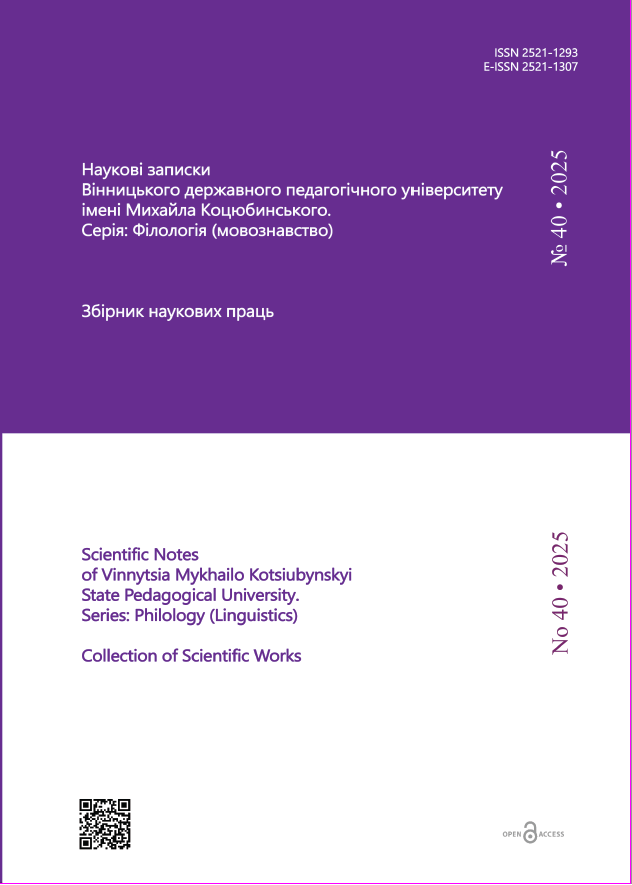Addresses in Polish: etiquette norms, communication models, functions
https://doi.org/10.31652/2521-1307-2025-40-07Published 2025-07-07
Keywords
- Polish language, addresses, communicative model, functions of addresses, etiquette norms

This work is licensed under a Creative Commons Attribution 4.0 International License.
How to Cite
Abstract
The article analyses addresses as an important component of speech communication. They reflect social, cultural and pragmatic features of the Polish language and the linguistic specificity of the society as a whole. The article focuses on the structure, functions, semantic characteristics of addresses and their stylistic use in communication. The knowledge of the models and functions of traditional and new addresses in the Polish language ensures effective and interesting communication with its speakers, as they are closely related to national traditions, religious and cultural values of the people, contain a social component, and demonstrate the relationship between language and culture. The relevance of the article is determined by both scientific and practical needs of linguistics, intercultural communication and teaching Polish. The Polish language is undergoing a transformation of etiquette norms, in particular, a decrease in formality in communication and the emergence of new models of addresses. The study of these changes is important for understanding the current state of Polish language culture. The aim of the article is to analyse the patterns of addresses typical for the Polish language, some aspects of their semantic, socio-cultural and pragmatic use in order to deepen the theoretical and practical basis for the analysis of Polish addresses, which takes into account their evolution, cultural specificity and the influence of modern world trends, which allows to identify the unique features of Polish speech etiquette. The modern Polish language, like many European languages, is undergoing a transformation of etiquette norms, a reduction in formality in communication, and its democratisation. All this contributes to the emergence of new models of addresses, the study of which is important for understanding the current state of Polish language culture and speech etiquette. The forms of address in Polish demonstrate the richness and diversity of the means of communication. However, forms are not only a grammatical means of communication, but also a way of reflecting rich cultural traditions and social norms: they demonstrate the level of politeness, emotionality, social status, and even regional identity. Despite the modern democratisation of the language, Polish addresses remain an important communication tool that allows us to maintain a balance between tradition and the latest trends in language. The forms of address in the Polish language demonstrate the richness and diversity of the means of communication. They adapt to social changes and different communication situations, providing both formal and informal communication; they are part of the culture and language etiquette of the country, which flexibly adapts to the context of communication in modern conditions. The right choice of the form of address is key to building effective communication, reflecting respect for the interlocutor, politeness and compliance with social norms. Forms of address are not only a grammatical means of communication, but also a way of reflecting a rich cultural tradition and social norms. They demonstrate a level of politeness, emotionality, social status and even regional identity. There is a wide variety of communication models, from formal to informal. Despite the modern democratisation of speech, Polish addresses remain an important communication tool that allows us to maintain a balance between tradition and the latest trends in speech. Undoubtedly, the topic of our research requires further study of the evolution of language etiquette. Therefore, further research will focus on the impact of digital communication, gender aspects and intercultural differences in the use of addresses.
Downloads
References
- Кононенко, І. В. (2012). Українська та польська мови: контрастивне дослідження. Варшава, 808 с.
- Стахнюк, Н. О. (2021). Польські адресативні звороти: граматика та омонімія мовленнєвого етикету. Закарпатські філологічні студії. Ужгород, вип. 17, том 1, с. 83-87. https://doi.org/10.32782/tps2663-4880/2021.17-1.16 DOI: https://doi.org/10.32782/tps2663-4880/2021.17-1.16
- Bartmiński, J. (2005). Pytania o przedmiot językoznawstwa : pojęcia językowego obrazu świata i tekstu w perspektywie polonistyki integralnej. Polonistyka w przebudowie. Literaturoznawstwo – wiedza o języku – wiedza o kulturze – edukacja. Kraków, 2005, s. 114–125. https://bazhum.muzhp.pl/media/texts/postscriptum/2004-2005-numer-2-148-49/postscriptum-r2004_2005-t-n2_148_49-s114-125.pdf (2.03.2025)
- Bartmiński, J. (1998). Tekst jako przedmiot tekstologii lingwistycznej. Tekst. Problemy teoretyczne. Lublin, s. 9-25.
- Sosnowski, W. (2015). Formy adresatywne. Aspekt językowy i socjologiczny. Semantyka a konfrontacja językowa, D. Roszko, J. Satoła-Staśkowiak (red.). Warszawa, s. 319-332.
- Jadacka, H. (2006). Kultura języka polskiego. Fleksja, słowotwórstwo, składnia. Warszawa : Wydawnictwo naukowe PWN, 252 s.
- Wierzbicka, A. (1991). Cross-Cultural Pragmatics: The Semantics of Human Interaction. Berlin : Mouton de Gruyter, 419 s. DOI: https://doi.org/10.1515/9783112329764





